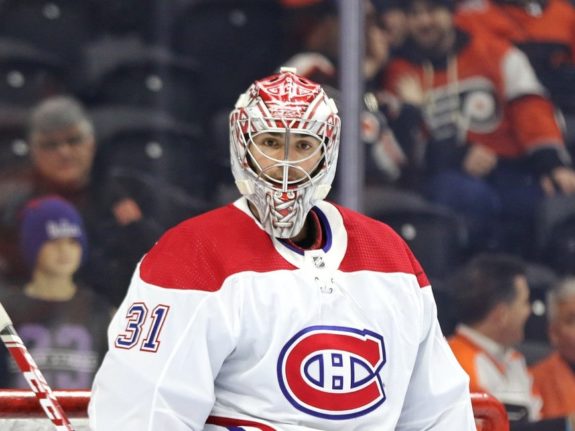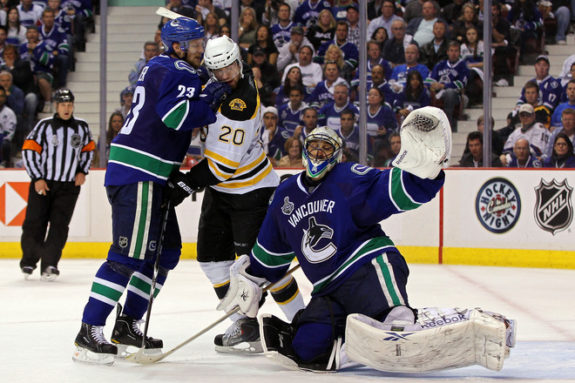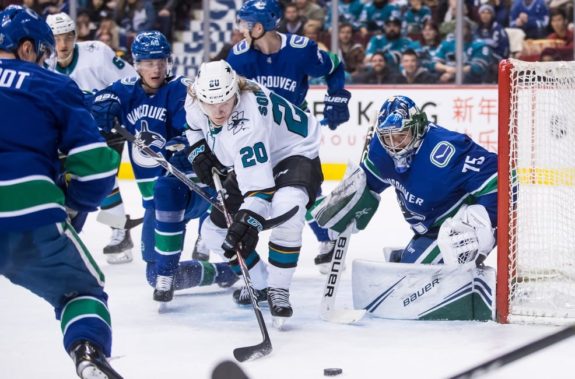As the Stanley Cup Playoffs have narrowed down the competition to the final two teams, one thing has been blatantly obvious: goaltending has made all the difference. Carey Price and Andrei Vasilevskiy are arguably two of the best goaltenders in the world and are going toe-to-toe to see who will be crowned champion. How does this relate to the Vancouver Canucks? While the stars have their role and defense had had a major impact, it’s the goaltending that will be the key to their future playoff success.
There have been stories of teams riding hot goaltending before, that’s no secret. But this year has been more evident than ever that the goaltending position needs to be solidified for a team to have any playoff success. We’ve seen it as the postseason has gone on, from the first round, right up to the Stanley Cup finals between the Montreal Canadiens and the Tampa Bay Lightning. From the Canucks perspective, it presents the opportunity to see how their goaltending compares to the more successful teams around the league.
The Goaltenders Remaining
The Stanley Cup Playoffs are meant to have the best of the best competing for Lord Stanley, and as the postseason has gone on, we’ve seen the best goaltenders slowly knock out their opponents, leaving us with arguably the two best-remaining netminders in Price and Vasilevskiy. A perfect example of this would be the semi-final matchups. At one end, we had a rematch of last year’s Eastern Conference Final, the Lightning vs. the New York Islanders. It was the battle of the defensive specials and goaltender Semyon Varlamov, and of course, the Lightning and Vasilevskiy, who speaks for himself (42 save victory in Game 2 of the Final). And the other matchup featured arguably the best goaltender in the world in Price, and this year’s Vezina winner (awarded to the most outstanding goaltender during the regular season) and three-time Stanley Cup Champion Marc-Andre Fleury of the Vegas Golden Knights.

Varlamov finished the season with a 19-11-4 record with seven shutouts, along with a 2.04 GAA (goals-against average) and a .929 SV% (save percentage). Varlamov has only had one season ever in which he has posted a sub .900 SV% (.898 SV% in 2016-17 with the Colorado Avalanche) and has proven to have been one of the more reliable goaltenders in the NHL over the last decade. Fleury has had a spectacular career and is a lock to be a first-ballot Hall of Famer. Despite being edged out in Pittsburgh in favour of Matt Murray (who is no longer a member of the Penguins organization) Fleury has flourished with the Golden Knights. At age 37, Fleury posted the best numbers of his career (1.98 GAA and .928 SV%) en route to winning his first ever Vezina Trophy.
As for the goaltenders remaining: there isn’t a whole lot of explaining that needs to be done regarding them. Vasilevskiy was a finalist for the Vezina Trophy this season and was the winner of it just a couple of years ago. He is a Stanley Cup Champion last season, well on his way to winning back-to-back Stanley Cups, and his numbers are outstanding. He has yet to have a season in which he’s had lower than a .910 SV%, and has a career .920 SV%. In the playoffs, his numbers somehow get better, owning a 2.25 GAA and a .924 SV%.
Price, on the other hand, has been the epitome of elite since he entered the league in the 2007-08 season. He has a career .917 SV% and in these playoffs is 12-7 with a 2.22 GAA and .926 SV%, all while missing the final 13 games of the regular season with a concussion. It’s not a coincidence that the two best goaltenders in the NHL are the last two standing battling it out for the Stanley Cup.
The Last Time Vancouver Was In The Final
It’s now been exactly 10 years since the Canucks faced off in the Stanley Cup Final against the Boston Bruins. One similarity of the finals in 2011 and this season is the goaltending matchups, where you had Roberto Luongo facing off against Tim Thomas. Both were Olympians a year prior, and Thomas took home the Conn Smythe Trophy as the playoffs MVP that year.

Luongo, during that season for Vancouver, had one of his best seasons, finishing with a 38-15-7 record along with a 2.11 GAA and a .928 SV%. Now the Canucks have had great goaltending seasons since with Corey Schneider (2011-2013 and most recently Thatcher Demko (2019), but that will need to be the level of play not only throughout the regular season but deep into the postseason (obviously) if Vancouver wants to get back to that point.
How The Goaltending Picture Looks for Vancouver Today
Finally, how does all of this relate back to the Canucks? When taking a look at the Canucks’ goaltending picture today, they are actually set up very well for the foreseeable future. Demko has shown signs of brilliance overstretches, including a little postseason success a year ago, and seems to be the goalie of the future. Brayden Holtby, while aging, is a reliable veteran who has won a Stanley Cup with the Washington Capitals, and they have a bright young prospect in Michael DiPietro developing within the organization.
As mentioned earlier, Demko has had stretches where he has been dominant and a main focal point to the Canucks’ success, especially this season when the Canucks rode him throughout the second half. Even in his brief playoff appearance in 2019, he sparkled in three games, posting a 0.85 GAA and a .985 SV%. Holtby was brought in last season after signing a 2-year, $8.6 million contract with the Canucks, and while he may be exposed to the expansion draft later this month, he’s been there before and only has a year remaining on his deal. Michael DiPietro was one of the best goaltenders in the OHL (Ontario Hockey League) from 2015-2019 and has been very strong with Vancouver’s AHL (American Hockey League) affiliate playing in nearly 40 games over the past few seasons.

Nobody is saying that any of the Canucks goaltenders, especially Demko and DiPietro, are going to be the next Price or Vasilevskiy, but if they can live up to the hype built around them and become consistent and reliable goaltenders for Vancouver, it gives them the best opportunity to get back to not only playing playoff hockey but play for the Stanley Cup for the first time since 2011.